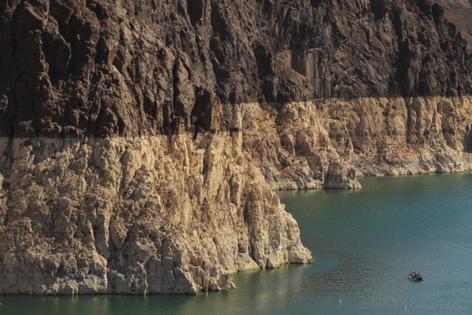A Lake Mead's worth of water has vanished from the ground. Could Las Vegas suffer?
Published in News & Features
The water beneath our feet that we use to bathe, drink and water crops is vanishing faster than ever in the Colorado River Basin, according to a new study.
From Arizona State University researchers, the study of satellite images has found that an amount of water comparable to Lake Mead has been lost from the ground in the period studied from April 2002 to October 2024. That’s roughly twice as fast as water on the surface.
For Jay Famiglietti, a study co-author who pioneered the practice of using satellites to study groundwater at ASU, the loss of 27.8 million acre-feet of groundwater should be a wake-up call for everyone from decision-makers to regular citizens who call the West home.
“Groundwater is a trans-generational resource,” Famiglietti said. “If we want our great-great-great-grandchildren to eat, then it’s time to think more holistically about the water that we use and what kind of protection it needs.”
While it’s true that Las Vegas relies on surface water from Lake Mead for 90% of its supply, that’s an increasingly limited resource it shares with six other states, Native American tribes and parts of Mexico.
And the overuse of groundwater — especially highlighted in Arizona — could prove to be a major problem as conflicts between water users flare in the future, causing more of a reliance on Colorado River surface water.
“Groundwater is key to our economic vitality,” Famiglietti said, “yet it remains sort of spottedly managed. Even where it is being managed, it’s unclear how effective the management will be.”
Spotlight on Arizona
The worst offender, by far, is Arizona when it comes to Colorado River Basin states.
Its $1.4 billion agricultural industry is largely propped up by groundwater, and only 18% of the state’s groundwater is subject to regulation and management, according to the study.
Under the state’s Groundwater Management Act of 1980, seven so-called “active management areas” exist in mostly urban areas, slowly weaning water users off of groundwater and onto surface water. The most recently designated one is the Wilcox basin east of Tucson, which officials approved last December.
A huge help to that mission came with the completion of the Central Arizona Project in the ’90s. Meant to stop over-reliance on groundwater, the 336-mile pipeline transports water from Lake Havasu to a distribution point near Tucson.
In a statement, the Arizona Department of Water Resources acknowledged the findings of the study as issues its water managers have long thought about.
“Protecting groundwater supplies throughout the state — both within the mainstem and outside the mainstem Colorado River Basin — is a major reason why Arizona is taking steps to expand its Groundwater Management Act protections to threatened regions,” a department spokesperson said.
Southern Nevada’s tie to groundwater
Though not highlighted in the study, the Las Vegas Valley Water District manages four groundwater-dependent delivery systems in the region: Blue Diamond, Kyle Canyon, Searchlight and Jean.
Continuous — sometimes hourly — monitoring of the aquifers that residents and businesses rely on in each of those systems helps water managers keep a close eye. All four of those aquifers’ levels tend to be responsive to rainfall, as well as snowmelt from the Spring Mountains.
Since 2020, the water district board has had a moratorium in place because of low aquifer levels, preventing any new connection hookups for the two wells that serve the neighborhoods near Red Rock Canyon.
In all four systems, water users are well acquainted with conservation rules that change depending on water levels, said Colby Pellegrino, deputy general manager of resources at the Southern Nevada Water Authority.
“We have gotten to the point where we have to say, ‘Hey, now is the time when you need to stop outdoor watering,’” Pellegrino said.
A ticking clock for 2027
Unanswered questions linger as Nevada and its neighbor states continue to negotiate throughout the next year.
Whatever they decide, the study’s authors are pushing for negotiators to consider groundwater and its stress on the entire Colorado River system in tense, ongoing interstate water negotiations to update each state’s river allocation by the end of 2026.
Karem Abdelmohsen, an ASU postdoctoral student who is the study’s lead author, said he and Famiglietti shared the results with Arizona water managers, who seemed receptive.
“The main message is that we are giving a lot of attention to surface water along the Colorado River, but groundwater needs a lot of attention as it is getting depleted in huge amounts,” Abdelmohsen said. “We need to slow down and give a chance for nature to refill our aquifers.”
It remains to be seen what approach Arizona officials will take to save its productive agricultural industry, though none seem to have floated the idea of building more diversions from the river.
Still, signs like this study point to more cuts for everyone involved as human-caused climate change and other factors dry up the Colorado River Basin.
“There’s no indication that Arizona is going to try and get more water from the Colorado River based upon what’s happening with their local groundwater,” said Pellegrino, of the Southern Nevada Water Authority. “They’ve got to figure out, just like everyone else, what does our post-2026 operating regime look like?”
_____
©2025 Las Vegas Review-Journal. Visit reviewjournal.com.. Distributed by Tribune Content Agency, LLC.







Comments